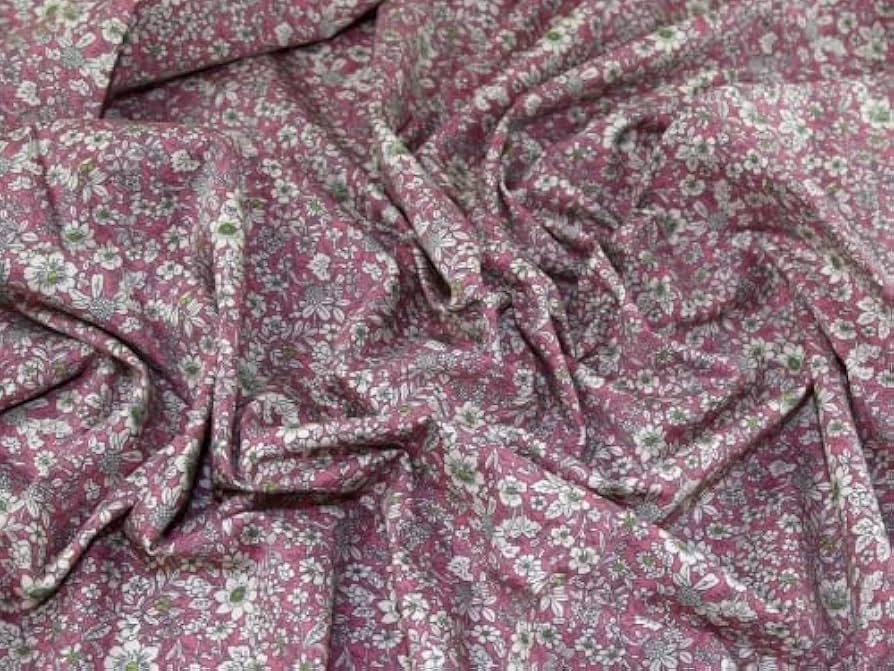
Selecting the best fabric is a crucial element of any fashion company that succeeds. Cotton is the most sought-after fabric among designers due to its durability and quality that is consistent. If you’re planning to build or scale an existing label, purchasing cotton fabric by the yard will help you reduce expenses, ensure high standards and allow the freedom to be creative.
This guide will explain the reasons why cotton is extensively used for fashion. It also explains the various types of cotton available, what you should look for when purchasing at the store, how to get your fabric, the best care tips, and ways to incorporate cotton to enhance your collection. In the end you’ll be equipped with practical tips to make informed, confident decisions to promote your business.
Why Cotton Fabric is a Top Choice
Cotton has stood firm throughout the centuries as a popular textile popular, and a myriad of positive reasons to support this.
Comfort You Can Rely On
The cotton fibers have a soft feel and are soft on skin. In contrast to other synthetic fabrics cotton isn’t known to cause irritation, which makes it perfect for casual wear. Fabrics made from cotton from the yard are comfortable throughout the day, no matter if it’s a light blouse, or durable jeans.
Breathable and All-Season Friendly
Many people choose cotton due to its breathability and natural properties. It allows air to circulate, ensuring that wearers stay cool during the summer times. However, cotton doesn’t stop with summer. The heavier weaves of cotton provide warmth and structure for colder climates, which makes it suitable all year round.
Flexibility Across Styles and Seasons
From stylish shirts to comfortable loungewear, cotton is able to adapt to a range of clothes. It’s a great absorber of dye and gives you vibrant colors that won’t fade easily. If you want to run an unassuming label or delve to bold patterns, the cotton fabric by yard provides a variety of choices.
Types of Cotton Fabric
All cotton is not created to be the same. The texture, quality and even the finish may differ depending on the type of cotton and the process. Below are the most popular types of cotton used in fashion:
Pima Cotton
It is known for its extremely long primary fibers Pima cotton creates a soft and durable fabric. It is resistant to pilling and keeps its shape throughout time. Brands that want soft and sturdy clothing typically choose Pima in dresses, shirts and top-quality basics.
Egyptian Cotton
Egyptian cotton is coveted for its absorbency and softness. The thick, long fibers form a tighter and softer weave. It’s a preferred choice for shirts with a premium finish as well as blouses and household linens that offer comfort and durability.
Upland Cotton
Upland cotton is the largest and most widely-grown cotton grown in the United States and forms the basis for a lot of cotton textiles. Although its fibers are a bit shorter that those from Pima and Egyptian cotton, the upland variety is a breeze to work with and is budget-friendly which makes it ideal for casual wear, T-shirts, and other versatile basic items.
Organic Cotton
It is free of pesticides and synthetic fertilizers organic cotton is appealing to companies that are focused on sustainability. The fabric provides the same level of comfort and breathability like regular cotton, but with less environmental impact.
Other Specialty Cottons
Cotton lawn, sateen voile, and jeans all have their place in fashion:
- The lawn is light and crisp, which is often used to make summer blouses and dresses.
- Satin is a soft shimmer, ideal for formal wear.
- Voile is light and airy, ideal to layer.
- The denim is strong and durable, making it ideal for jackets and jeans.
When you purchase cotton fabric by yard, knowing your kind will help you choose the perfect size for each item in your collection.
Factors to Consider When Buying Cotton Fabric by the Yard
Selecting cotton, in small or bulk quantities it is about understanding what differentiates one bolt from the other. Here are the most important things to look for:
Thread Count
Thread count is how many threads are woven into a square inch of fabric. The higher the thread count typically implies a softer, more smooth feel, perfect for dresses and shirts. Lower thread counts may provide greater durability, making the garments suitable for workwear and outerwear.
Weave
The weave affects the texture as well as drape. It also affects how the fabric behaves after sewing. The most common weaves are plain, satin, and twill. Plain weaves are an easy, balanced fabric. Twill is a diagonal-patterned fabric that gives jeans their distinctive toughness. Satin weave provides a glossy appearance, perfect for more formal clothing.
Weight
The weight of fabric can be determined in gallons per square meters (GSM). Lightweight cotton is great to make linings and blouses while heavyweights or medium weights are ideal for jackets, pants, or formal dresses. Always think about the final purpose before buying fabric in the yard.
Finish
Fabric finishes may include pre-shrinking and the process of mercerization (which enhances the shine and strength of your fabric) as well as treatments to create a wrinkle-resistant fabric. Choose the right finish for your style and needs.
Color and Print Quality
Cotton is able to absorb inks, and print well giving real, long-lasting colors and sharp designs. Always request swatches prior to a huge order especially if you require specific colors or prints.
Where to Buy Cotton Fabric by the Yard
Finding high-quality cotton requires an array of research, networking and testing. Check out these sources to find the top suppliers for your company:
Online Retailers
Websites such as Fabriclore, Mood Fabrics, Fabric.com, and Dharma Trading Co. stock many different cottons that include organic and specialty kinds. Online shopping allows you to review prices, compare prices and request swatches prior to you deciding to invest.
Local Fabric Stores
Local shops let you test the fabric on your own. This is helpful for getting a feel for the quality and the quality of the finish. Making connections with the owners of the store could provide better discounts or custom orders in the future.
Trade Shows and Expos
Trade shows such as Texworld USA or Premiere Vision draw suppliers from all over the world. These shows are ideal for spotting new cotton fabric by the yard, obtaining samples, and bargaining bulk prices.
Tips for Finding Reliable Suppliers
- Always request a sample of fabric or swatch prior to making a major purchase.
- Read reviews about the supplier and request references.
- Start with a smaller order to make sure that you are consistent before moving up.
- Make sure you know the return and refund policy prior to the time of your return.
Tips for Caring for Cotton Fabric
Maintaining the high-quality of your designs begins by following good care guidelines. Here are a few easy, effective methods to ensure that your cotton clothing last longer
Washing
Wash your cotton in warm or cool water to stop shrinking and fade. Make use of mild detergents and stay clear of harsh chemicals that could destroy fibers. Separate colors and whites to stop bleeding of colors.
Drying
Drying with air is the best method to preserve cotton’s structure and color. If you must utilize a dryer, select a setting with a low temperature. Take off the clothes quickly to avoid wrinkles.
Ironing and Storage
The ironing process is often beneficial for cotton using an iron that is medium-hot while the fabric is damp. Keep cotton clothes in a cool and dry location. Do not hang heavy cotton clothes in a way that could alter their shape.
Preventing Shrinkage and Fading
The process of washing fabric prior to sewing can help to prevent shrinkage in the future. To maintain vibrant colors Turn the fabric inside-out prior to cleaning and drying.
Creative Uses for Cotton Fabric
It’s not just for T-shirts and button-downs. Here are a few innovative ways that fashion brands can make use of cotton fabric by the yard:
Apparel
- Summer skirts, dresses and pants with wide legs made of voile or cotton lawn feel soft and breathable.
- Chinos, work shirts, and jackets made of denim or twill offer the structure and durability.
- Lingerie and loungewear are given added comfort with the soft cotton jersey.
Accessories
- Scarves, totes and hats made from printed cotton add character to any collection.
- Scrunchies and headbands are a great way to use up fabric scraps, and expand your range of products.
Home and Lifestyle
- Table linens, pillows and quilts take advantage of cotton’s strength and washability.
- Wraps made of cotton and napkins that are reusable go well with eco-friendly, sustainable branding.
DIY Projects
- Create a scrap-busting campaign inviting your guests to make crafts using cotton scraps.
- Limited edition items are available using blocks-printed or hand-dyed cotton. the yard.
Make Cotton Fabric by the Yard Work for You
The investment in cotton fabric in the form of a yard provides distinct advantages for fashion labels. The ease of use, flexibility and variety of styles makes cotton an essential for designers across the globe. You can control budgets, experiment with innovative ideas at a reasonable cost and provide high-quality products to your clients.
If you take into consideration the thread count, weave and the quality of your supplier you’ll avoid mistakes and make an item that is distinctive by its quality and style. If properly cared for your items will last for a long time and keep customers returning to purchase more. Make use of the versatility of cotton to expand into new categories of products or simply improve your existing favorites.
When you’re setting up your first line or looking to step up your sourcing of fabrics, getting cotton fabric by the yard is an effective simple move.
Our wide selection of custom printed, ready mill-dyed, and yarn-dyed fabrics—ideal for bringing your next collection to life. For tailored support or any queries, feel free to contact us at hello@fabriclore.com. With Fabriclore, enjoy a smooth, reliable, and budget-friendly fabric sourcing experience.



